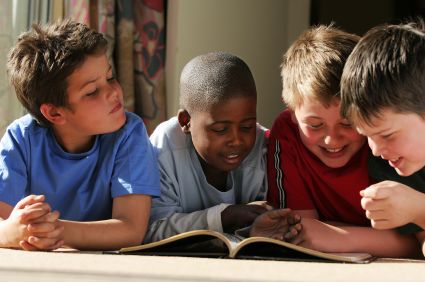Boys’ literacy is one of the most current issues in education.
Trying to involve young children in reading actively is a constant issue for teachers and parents. Boys’ literacy has come to the forefront in Education across the world, with Canada, Australia, Great Britain and the United States taking active roles in addressing these concerns. Research suggests that a significant percentage of boys do not like to read or do not think they read well.
Choice and Frequency
The most significant factors in engaging boys to read is letting them have choices of literature and giving them time to read. Too often they are solely exposed to narrative texts, which research shows does not interest them fully. Boys must be permitted to choose from a variety of texts that include both fiction and non-fiction and in which the following chances occur:
Books that make them laugh.
Literature that contains some factual information like baseball cards, magazines, comic books or instruction manuals.
Science fiction or fantasy literature.
Books are available in which the focus is more on what the characters do and not on his or her emotions.
Once a student has selected their material to read, they must be given sufficient reading time on a consistent basis. Fluency in reading is an important indicator of success. Research shows that even if the reading level is below what a student is capable of, it is important that boys need to feel they are successful regardless of the difficulty.
Equity for All
Throughout the boys’ literacy debate, an issue to remember is to not ignore the girls. While boys do have various learning styles and behaviors, literacy achievement is an issue to concentrate on equally amongst both boys and girls. Governments and schools must be acutely aware not to segregate girls’ and boys’ differing needs and abilities through teaching strategies and resources. Diverse literature should be made available to meet both boys’ and girls’ tastes. Most of the suggested practices are applicable to all students. For example, girls must be given the opportunity to choose what they want to read and not assume that because they are girls, they only enjoy reading narrative texts.
While it is needed to reflect on developing teaching practices that meet boys’ literacy needs, it is also very important not to do so at the expense of the girls, i.e., creating a reading club that only targets one group, in this case the boys. Girls will naturally feel neglected and their own attitude towards literacy will be affected. Literacy must be handled equally; schools must actively create opportunities for both genders to improve themselves. While the issue of boys’ literacy is important, there are many elements that must be addressed for both genders.
Redefining Literacy
In finding the solution to engaging boys in reading, we must also expand our definition of literacy. Literacy includes the ability for someone to navigate through any text and make sense of it. Books are only one type of text, and it is unfortunate that schools don’t offer more of a variety of texts for students to interact with. While books can help many children to discover reading, other forms of texts include magazines, instruction manuals, Internet sites, information books, comic books, and so on. Boys enjoy reading about facts and will be more encouraged to read if their learning environment includes a variety of reading options.
Teachers, schools and governments must be acutely aware that current standardized literacy assessments do not motivate boys to perform at their best. Changing those assessments to reflect what boys like to read, would affect the results in a more positive manner. Boys might then be more comfortable with sharing and writing their ideas, thereby developing their self-image when it comes to reading. Attitude improvement is necessary to attaining strong literacy skills. Educators need to adjust their views of literacy achievement and expand their understanding of literacy to encompass different forms of media (TV, Internet, radio, magazines) and texts to better prepare their students.
Role of Teachers
- Offer a wide variety of literature including non-fiction.
- Permit all students to choose what they want to read.
- Give boys the freedom to write in whatever form they are comfortable with – point form, webs, concept maps and so on
- Motivate peer evaluation to build confidence and ownership.
- Allow students to offer their ideas without teacher interference.
- Develop literature circles – gives all students a chance to orally share their findings.
- Use technology to get boys interested in literacy.
- Inspire and stimulate boys to read through a positive and enthusiastic delivery.
- Be specifically aware of how you organize your classroom, keeping boys away from the distraction of their friends.
- Use the arts to bring literacy to life.
- Give shorter tasks for boys that will make their contributions more meaningful and provide frequent feedback.
- Allow boys to be humorous in their writing.
- Be flexible in your demands, allowing for creativity that goes beyond your expectations.
- Be positive in your approach that will foster an environment where all their contributions are worthwhile.
- Provide male role models that read to the students.
- Allow the students to help shape their activity so they feel ownership over the results.
